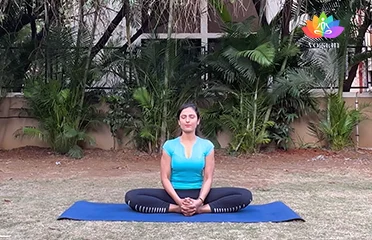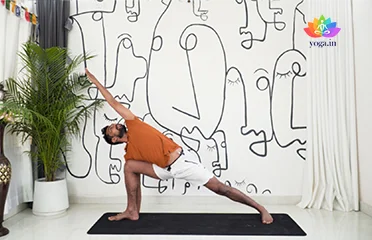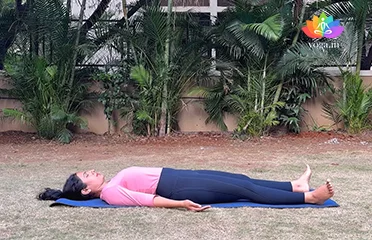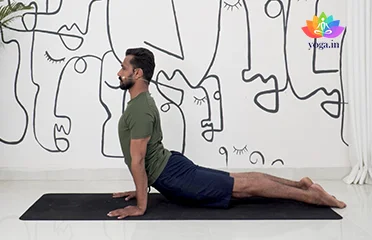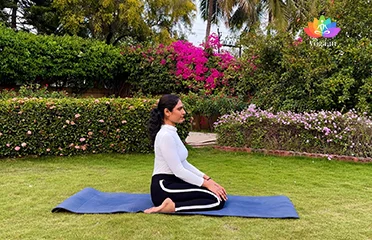Bhadrasana (Gracious Pose | Butterfly Po
भद्रासन / Gracious Pose | Butterfly Pose
The Sanskrit name is derived from Bhadra (भद्रा) meaning gracious, [�K]
Parsvakonasana (Extended Lateral Angle P
पार्श्वकोनासन / Extended Lateral Angle Pose
The Sanskrit name is derived from Parsva (पार्श्व) meaning side, [�K]
Savasana (Corpse Pose)
शवासना / Corpse Pose
The Sanskrit name is derived from Śhava (शव) meaning "corpse" and āsana [�K]
Urdhva Mukha Svanasana (Upward-Facing Do
ऊर्ध्वमुखश्वानासन / Upward-Facing Dog Pose
The Sanskrit name is derived from Urdhva (ऊर्ध्व) meaning up, Mukha [�K]
Virasana (Hero Pose)
वीरासन / Hero Pose
The Sanskrit name is derived from Vira (वीरा) meaning hero or a warrior [�K]
How Yoga Can Help Cure Leg Pain:
Leg pain can arise from various causes such as muscle strain, poor circulation, or chronic conditions like arthritis. Yoga can be an effective way to manage and alleviate leg pain by improving flexibility, strengthening muscles, and enhancing blood flow. Through targeted yoga postures, breathing exercises, and relaxation techniques, yoga can provide significant relief from leg pain.
Understanding Leg Pain:
Leg pain refers to any discomfort or ache experienced in the legs, ranging from mild to severe. It can be acute (short-term) or chronic (long-lasting) and might affect different parts of the leg, such as the thighs, knees, calves, or feet. Causes of leg pain can include injuries, overuse, nerve issues, or underlying health conditions.
Yoga’s Role in Relieving Leg Pain:
Specific yoga practices can help alleviate leg pain by enhancing muscle strength, improving flexibility, and promoting better circulation. Yoga poses that target the legs can stretch tight muscles, release tension, and reduce inflammation. Additionally, pranayama (breathing exercises) and relaxation techniques can help manage pain by reducing stress and promoting overall well-being.
Key Factors Contributing to Leg Pain:
Several factors can contribute to the development of leg pain, including:
- Muscle Strain: Overuse or injury to the leg muscles.
- Poor Circulation: Reduced blood flow to the legs.
- Nerve Damage: Conditions like sciatica that affect the nerves.
- Joint Issues: Arthritis or other joint problems.
- Injuries: Fractures, sprains, or other leg injuries.
- Chronic Conditions: Diabetes, varicose veins, or other health issues.
Symptoms of Leg Pain:
Common symptoms of leg pain include:
- Aching or Throbbing: Persistent discomfort in one or both legs.
- Swelling: Inflammation or puffiness in the legs.
- Sharp Pain: Sudden, intense pain, especially during movement.
- Numbness or Tingling: Sensation of pins and needles in the legs.
- Weakness: Reduced strength or stability in the legs.
- Redness or Warmth: Signs of infection or inflammation.
Treatment of Leg Pain through Yoga and Pranayama:
Yoga and pranayama can be very beneficial in managing leg pain. Some effective practices include:
Specific Yoga Poses:
- Supta Padangusthasana (Reclining Hand-to-Big-Toe Pose): Stretches the hamstrings and calves, improving flexibility.
- Viparita Karani (Legs-Up-the-Wall Pose): Enhances blood circulation and reduces swelling.
- Anjaneyasana (Low Lunge): Strengthens and stretches the thighs and hips.
Pranayama Exercises:
- Anulom Vilom (Alternate Nostril Breathing): Balances the mind and body, reducing stress-related pain.
- Ujjayi (Ocean Breath): Calms the nervous system and promotes relaxation.
Diet for Leg Pain:
A balanced diet can help manage leg pain. Recommendations include:
- Anti-Inflammatory Foods: Incorporate turmeric, ginger, and leafy greens to reduce inflammation.
- Hydration: Drink plenty of water to stay hydrated and support muscle function.
- Lean Proteins: Chicken, fish, and beans help repair and build muscle tissue.
- Omega-3 Fatty Acids: Found in fish, flaxseeds, and walnuts, these support joint health.
- Calcium and Vitamin D: Dairy products, almonds, and fortified cereals strengthen bones.
Caution for Leg Pain:
While practicing yoga for leg pain, it is essential to:
- Avoid Overexertion: Practice at a gentle pace to prevent strain or injury.
- Be Mindful of Pain: Stop immediately if any pose causes discomfort or exacerbates pain.
Always consult with a healthcare provider before starting any new exercise regimen, especially if you have severe leg pain or an underlying condition.
Contraindications for Leg Pain:
Individuals with severe leg pain or certain medical conditions should:
- Avoid Intense Yoga Practices: Vigorous exercises might worsen symptoms.
- Steer Clear of Certain Poses: Avoid poses that put excessive strain on the legs or joints.
- Seek Professional Guidance: Consult a yoga therapist or healthcare professional for personalized recommendations.


